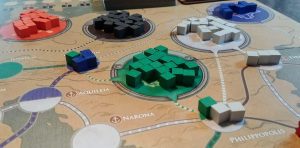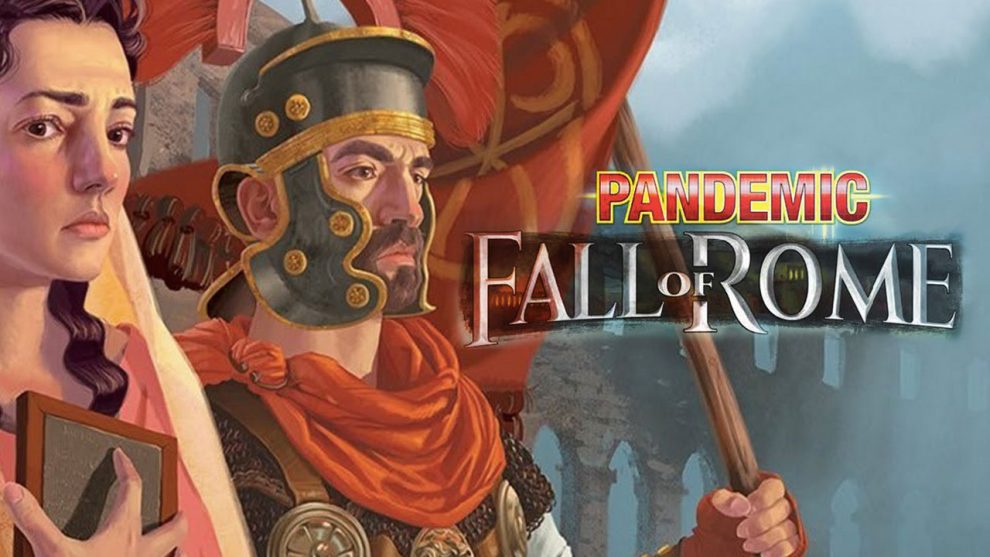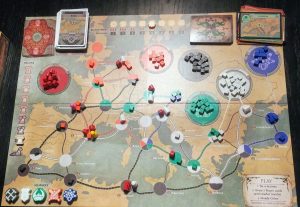The horde is at the gates! The greatness of Rome, her culture, and her people are in peril! Can you fight off the invasion, build strategic alliances, and preserve Rome for all eternity?
Pandemic: Fall of Rome is a standalone 1-5 player co-op game that represents a delightful twist on traditional Pandemic. Playing in just 45-60 minutes, Pandemic: Fall of Rome immerses players in both the geography and the historical challenge of staving off advancing “barbarian” tribes as Rome declines.
How To Win
Pandemic: Fall of Rome requires you to defend Rome from her enemies either by forging alliances or by eliminating all of a faction’s units from the map, all before the Rome slips to the bottom of the Decline track.
How To Play
Many of the same mechanisms you have grown to love in the original Pandemic game are alive and well in Pandemic: Fall of Rome. An “invasion deck” spreads the invaders across the map. Players take four actions per turn and draw from a common City Deck to collect color-coded province cards. Instead of curing disease with the colored cards, you are forging alliances with advancing tribes. The mechanism of set collection to achieve victory conditions is virtually unchanged.
But despite the similarities to original Pandemic, there is plenty of new content to hold my interest. For example:
- The barbarian tribes have different numbers of cubes. Tribes with fewer cubes available create greater risk in the early game, increasing anxiety as players triage the onslaught.

- You have to raise Legions and deploy them in combat to fend off the barbarian tribes.
- The tribes progress down specific paths, allowing you to attempt some planning to establish strategic chokepoints, though the progression sometimes can happen more quickly than you are able to anticipate!
- There are also special thematic roles that provide character-specific advantages, such as Consul, Merchant, Master Builder, Barbarian Queen, Vestal Virgin, Civil Engineer, Military General, and Admiral.
- For most roles, moving around the map takes a long time, as you would expect in the ancient world. It is challenging but satisfying.
- You can win without collecting every set. Clearing all cubes of one color from play will render that tribe “controlled” so long as you can keep the board clear. That way you can perform both alliance building and map clearing to improve your chances of winning.
Design Successes
Combat

There are many design elements that keep me coming back to Pandemic: Fall of Rome. I adore how the game handles the abstraction of combat. The special combat dice are simple and effective. You roll one die for each Legion you commit to combat, up to a max of 3. And though combat is necessary, it is not always the best option. I appreciate how using the Legions defensively emerges as a quality strategy. Legions can be left behind to block a position on a road (like a road block) or can be parked in a city with three barbarian units (like a quarantine token). Legions will soak new invaders, preventing a riot and keeping the Decline track from dropping.
Migration Paths
 The setup of the barbarians offers enough variety to be compelling, but what really works is the explosion of one particular tribe, the Vandals, in the late game. This is especially thematic, as the Vandals have the longest route to travel to reach Rome. Also, the Vandals are barely present in the early game, so players are focused on the other four tribes in the early game. But by the later game, the tables have likely turned and the board often is a sea of Vandals black cubes.
The setup of the barbarians offers enough variety to be compelling, but what really works is the explosion of one particular tribe, the Vandals, in the late game. This is especially thematic, as the Vandals have the longest route to travel to reach Rome. Also, the Vandals are barely present in the early game, so players are focused on the other four tribes in the early game. But by the later game, the tables have likely turned and the board often is a sea of Vandals black cubes.
In fact, the whole migration path mechanism introduces terrain and geography in a simple but meaningful way, allowing defensive chokepoints and some military planning to take place. You must choose where to make your stand, and the quality of that choice can mean success or failure.
The shift in overall control from Rome to the invaders is also very smooth. The shift in power can accelerate unnoticeably until the Romans are in big trouble. Hardly any of my 15 games were runaways, instead requiring all my focus and diligence to manage the advancing invaders.
Scope & Scale
The board itself is beautifully done, but more compelling is that it is challenging to navigate. You get a sense of just how vast the empire was at its height because it is tough to move quickly across great portions of it. As such, the challenge of travel heightens the “ancient” quality of theme. It’s just hard to get around, so you have to spread out to defend a large area…which makes it tougher to share city cards needed to forge alliances.
Balance & Challenge
Overall, I feel the scaling of difficulty is well done. Depending on your experience level with Pandemic, you can choose fewer or more “Revolt” cards to tweak the difficulty. Players can start with easy Introductory-level settings to play their first game and learn the rules. Quickly, though, you will want to add in more Revolt cards to find your “just-right” level of challenge. There is also a special, optional rule (Roma Caput Mundi) that I will always use, one that prevents troops from setting foot in Rome. That rule cements the historicity of the game for me. While it does make the game more difficult, Roma Caput Mundi pleases me (and no doubt the Senate as well) to know that no legions will enter Rome.
With five separate factions, each with different amounts of cards and available units, variable setup, and eight player roles, the game presents very high replayability. I can even solo the game with ease using the single-player rule set. As a result, this game makes the table frequently.
Design Quibbles
With all that said, because I clearly enjoy this game and endorse it whole-heartedly, I still have quibbles.
Differentiation from Pandemic
I wish there were more mechanisms that further differentiate this version from original Pandemic. The fact that the other players at the table would frequently verbalize the wrong terms (“Infect” when they mean “Invade” or “Outbreak” when they meant “Decline”) and that the use of the incorrect terms in no way impeded our ability to play the game showcases that some of the theme was merely applied to an existing game structure, which is less satisfying. 
Historical Flavor
In addition, the game takes an overly simplistic view of the demise of Rome, which sabotaged itself from the inside with political infighting, financial instability, and on and on. While the shortage of manpower is well-represented in the late game, the internal dysfunction and chaos is abstracted in a somewhat unsatisfying decline track. I suppose that abstraction is necessary – after all, this is not a simulation of the fall of the empire, which would be a different game entirely – so I will not quibble beyond saying I just wanted more flavor of Rome being internally dysfunctional rather than merely overwhelmed by outsiders.
Special Roles
 I also found the special roles disproportionately compelling. After 15 plays with multiple groups, I can attest that certain roles are rarely used (Mercator, I am looking at you) while others (like the barbarian queen) are considered virtually essential to achieve victory. It would be a great expansion to the game to have more roles to choose from.
I also found the special roles disproportionately compelling. After 15 plays with multiple groups, I can attest that certain roles are rarely used (Mercator, I am looking at you) while others (like the barbarian queen) are considered virtually essential to achieve victory. It would be a great expansion to the game to have more roles to choose from.
Game Setup
Lastly, like core Pandemic, setup is exceptionally tedious. You sort colored cubes into five groups, extract specific cards from the invasion deck, separate event cards from city cards in the player deck, select specific number of event cards, shuffle back into the player deck, choose number of revolts to tune the difficulty, begin the invasion by placing starting cubes, deal starting cards to players, then stage the revolts into the remaining player deck cards. It’s a ton of work just to get the game started.
Final Thoughts
Pandemic: Fall of Rome is a great game, familiar enough to Pandemic veterans to be easy to adopt while being different enough to offer a fresh challenge. Of all the Pandemic-style games, this one is my favorite.












Add Comment